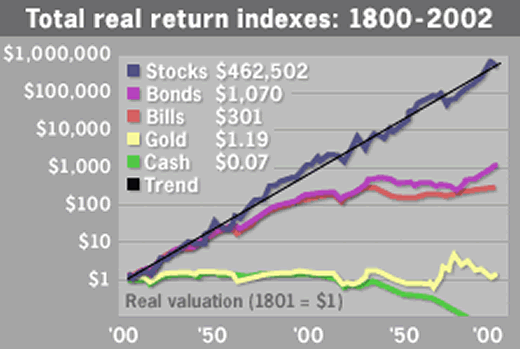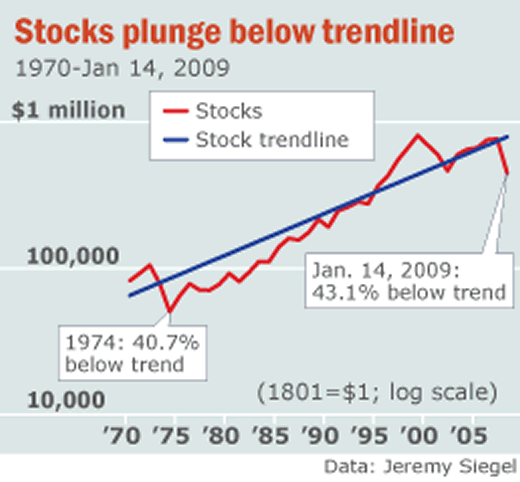Worst Stocks Bear Market for 200 Years!
Stock-Markets / Stocks Bear Market Jan 22, 2009 - 09:37 AM GMTBy: Oxbury_Research
 We have featured the work of Wharton Finance Professor Jeremy Siegel on a number of occasions and are doing so again to get some badly needed perspective on what is, by all objective accounts, a very confusing current market picture.
We have featured the work of Wharton Finance Professor Jeremy Siegel on a number of occasions and are doing so again to get some badly needed perspective on what is, by all objective accounts, a very confusing current market picture.
Siegel's work has both adherents and detractors, but it's hard to argue with his data. His most famous work may be the following bit of pictorial pulchritude:

Plotted on log scale so that percentage gains are apparent (rather than nominal gains), Siegel has traced the value of a single dollar invested in a number of asset classes from 1800 until the present. His findings are shown on the chart above.
In short, a dollar invested in stocks has produced gains that dwarf all other asset classes. On average, equities have returned 7% per year for the last two centuries. Cash has become worthless, while gold, interestingly, has proven itself a near perfect store of value. One dollar of gold purchased in 1800 has returned nearly exactly that – one dollar nineteen cents. (This may be the most compelling argument for those who maintain that gold is the ultimate hedge against inflation.)
Whether or not any of these trends will continue into the future is a point of debate for another time. What is most interesting for us at this juncture is the absolutely straight regression line that marks the return in equities over the period in question. It is to this straight line that we now turn our attention.
A Truer Regression to the Mean?
Many of the arguments of the investment world's perma-bears center around the phenomenon of “regression to the mean,” a perfectly legitimate line of reasoning that states:
• that there is a verifiable, historical statistical norm, and
• that deviations from that norm are eventually corrected such that
• the long term historical trend remains in force.
The bears employ this argument with respect to dividend yields, P/E ratios and a host of other metrics to prove that the market is out of whack and has to fall before we can be sure that it's safe to own equities again.
Nothing wrong with that.
Until Professor Siegel comes along with his charts and explains otherwise. According to him (via the chart above), the regression line that is most significant to equity ownership has, in fact, been adhered to remarkably well for hundreds of years, and we needn't worry about doing anything but buying equities and holding them for the long term.
Here is another look at his equity return line for the last 40 years.

What can be seen here are the dips and jabs above and below the regression line that mark the overbought and oversold moments in market history since 1970. Deeply oversold markets in 1974 (40.7% below trend) and 1981 (40% below trend) were only worsted by the grand-daddy bear market of 1932, which brought equities 42% below trend (not shown).
Until now.
Siegel's research shows that the 2008 bear market has brought stocks 43.1% below trend, pointing to a bear market relatively worse than anything we have seen for the last 200 years!
Does that mean stocks will not fall further? Absolutely not. Things can fall apart (as nearly everything eventually must). And we have certainly entered a new era where the results of unprecedented central bank meddling will reap consequences unknown, unintended and likely dire. But, at the same time, investors must also be aware that two hundred years of history has a momentum of its own – and must also be reckoned with.
Therefore, should we regress to the mean that Professor Siegel's work points us toward, we could be witnessing the S&P 500 back between 1200 and 1400 in no time.
Conversely, Siegel's work indicates that there's no historical precedent for indexes to fall significantly from these levels. Figure out what history means to you, and take that for what it's worth.
Option strategies for the Siegel-wise
If Siegel's data and the conclusions drawn from them make sense to you, there are some fairly straightforward options strategies that could net you (limited) profits while at the same time minimizing your risks.
We would recommend bull put spreads on the SPY with a nice cushion on them – earliest expiration April. That should give the market time enough to find its feet. And be sure both strikes chosen are below the November lows of 75.
For those who've never traded them, there's lots of liquidity in the SPYs. Pick the credit spread of your choice (and the amount you're willing to risk) and set up shop.
If the Siegel pop comes as we expect it should, you'll walk away with your chosen credit easily.
“Our ignorance of history causes us to slander our own times.” – Flaubert
Matt McAbby
Analyst, Oxbury Research
After graduating from Harvard University in 1989, Matt worked as a Financial Advisor at Wood Gundy Private Client Investments (now CIBC World Markets). After several successful years, he moved over to the analysis side of the business and has written extensively for some of corporate Canada's largest financial institutions.
Oxbury Research originally formed as an underground investment club, Oxbury Publishing is comprised of a wide variety of Wall Street professionals - from equity analysts to futures floor traders – all independent thinkers and all capital market veterans.
© 2009 Copyright Oxbury Research - All Rights Reserved
Disclaimer: The above is a matter of opinion provided for general information purposes only and is not intended as investment advice. Information and analysis above are derived from sources and utilising methods believed to be reliable, but we cannot accept responsibility for any losses you may incur as a result of this analysis. Individuals should consult with their personal financial advisors.
Oxbury Research Archive |
© 2005-2022 http://www.MarketOracle.co.uk - The Market Oracle is a FREE Daily Financial Markets Analysis & Forecasting online publication.



